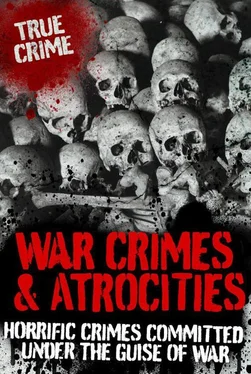In this way, the French people became polarized into two factions: those who collaborated with the Nazis, and those who helped the Resistance forces. With the threat of death and torture hanging over anyone who resisted the regime, there were also many who changed sides, or who played a game of double dealing throughout the war. The whole atmosphere of the country was rife with paranoia, as spies and tale-tellers vied with resistance sympathizers, causing an immense burden of guilt and shame, together with bitter feuding on both sides, which lasted well beyond the war years. Even today, there is much controversy as to how much the French were forced to collaborate in sending the Jews to the concentration camps, and how much their actions were due to entrenched anti-Semitism within the country.
THE PARIS DEPORTATIONS
When the Germans first occupied the country, it did not immediately become clear that mass genocide of the Jews was one of their main objectives. The sheer scale of what was intended went well beyond most people’s worst nightmares, and there were many – including Jewish people themselves – who simply did not believe what was going on, in terms of mass extermination in the concentration camps, until it was too late to escape. One such group were the Jewish people of Paris.
After the invasion of the Germans, many Jewish Parisians moved to the French countryside or abroad to avoid the restrictions that were placed on them. As the result of the Nazis’ regulations, many lived in fear of the authorities and were unable to earn a living. Given the fact that many had been forced to flee communist Russia and were attempting to rebuild their lives in a foreign country, this new form of persecution was particularly harsh. However, most had no inkling that they would be rounded up, sent to concentration camps and gassed to death, and therefore remained where they were, rather than abandon everything they had built up and move abroad. Some went to the countryside with the intention of returning as soon as the war was over, or as soon as conditions became more favourable to their leading a normal life in the city once more.
They could not have known how swift, and how deadly, their end would be. On two days in July 1942, the 16th and 17th, the Nazis rounded up 12,884 non-French Jews to be deported to their concentration camps in Poland. Before they left, almost 7,000 of them were held in a single stadium, the Vélodrome d’Hiver, on the Boulevard de Grenelle. The majority of the victims were children. Incredibly, there were only four toilets available for them to use. After a whole week, during which they were not given adequate supplies of food or water, the victims were transferred to ‘collection’ camps at Pithiviers and Drancy, outside Paris, where the children were separated from their parents. The parents were then taken to Auchwitz, where they were herded into gas chambers and gassed to death. The children followed soon after. All 4,051 of them died. At the end of the war, only 30 of the adults who had been sent to Auchwitz in the Paris Deportations were still alive.
CHILDREN EXTERMINATED
In total, around 60,000 Jews died in France during the war, under the German occupation. Not only adults, but many children and teenagers were also sent to the concentration camps, often alone without their families. For example, on 11 June, 1941, 300 Jewish boys aged between 14 and 19, were deported to Mauthausen concentration camp in Austria. All of them died.
In another instance, Jewish orphans aged between fiveand 17, living at an orphanage in Izieu, central France, became victims of the Gestapo. On 6 April, 1944, Gestapo Officer Klaus Barbie, known as the ‘Butcher of Lyon’ because of his brutality, arrived with a convoy of trucks outside the building. His soldiers gained entry and forcibly removed 44 children and seven adults, throwing them onto the waiting trucks as they cried out in terror. The defenceless children were then taken to the camp at Drancy, where they were put on trains going to the concentration camps. Most of them were gassed to death in Auchwitz, while others met their end in Tallin, Estonia, shot by a firing squad.
After the war, Klaus Barbie was arrested for this and other war crimes, and was sentenced to life imprisonment. He died in prison of cancer in 1991. He was thought to have been responsible for the deportation of over 7,000 people to the death camps, and to have ordered the murder of over 4,000 more. In addition, he oversaw the torture of around 14,000 members of the Resistance movement.
THE FINAL SOLUTION
It was not until after the war that the full extent of the Holocaust became apparent. In the early days of Jewish persecution under the Nazis, death squads were used to round up and shoot Jews in conquered territory. However, this method proved too slow for Hitler and his henchmen, so from 1941, a policy of mass genocide was pursued, known as the Final Solution. Under this new scheme, extermination camps were set up with the specific aim to kill as many Jews as possible, as quickly as possible. Industrial methods were developed to exterminate victims in gas chambers and burn their bodies in large furnaces on a scale never known before. Jews who had been living in overcrowded, disease-ridden ghettos all over Europe were arrested and transported to the camps on trains and in cattle trucks, still in many cases unaware of the fate that was to befall them. Once there, they were either gassed, shot or left to survive as best they could, in conditions of unimaginable filth and neglect. Many did not survive the war, starving to death or dying of disease.
FRENCH ANTI-SEMITISIM
It became shamefully apparent after the war that the French collaboration with this barbaric scheme had been extensive. Philippe Petain, leader of the Vichy government and a hero of World War I, supported the Nazi regime, arguing that the French people would suffer less under it if his government cooperated. However, it seems that his government did more than cooperate with the Germans: it actively participated in the persecution of the Jews, setting up a secret police, the Milice, to inform on individuals and have them arrested and deported. The Milice, along with right-wing activists, such as members of Jacques Doriot’s Parti Populaire Français (PPF), are thought to have been responsible for arresting at least 75,000 Jews for deportation to the death camps. It has also been argued that it was the Milice, and not the Nazis, who were responsible for the Paris Deportations, in which over 12,000 Jews were rounded up in a stadium for deportation. According to this account, the Nazis did not demand the arrest of the 4,051 children who were included in the round-up.
Many commentators also claim that there were many far-right factions in French society who were all too eager to help the government in their task of sending Jews to the concentration camps, and that anti-Semitism had been deeply entrenched in France for centuries. Thus, when the Nazis took over power, this provided an ideal opportunity for the far right, both within and outside the government, to put their racist beliefs into practise on a hitherto unimaginable scale.
MAURICE PAPON
One individual who was singled out as a collaborator was Maurice Papon, a high-ranking government official and the supervisor of its so-called ‘Service for Jewish Questions’. Papon switched allegiances during the war and moved up the political ladder swiftly, until his war crimes were uncovered. He was known to have had regular contact with Nazi Germany SS corps who were responsible for the mass cleansing of the Jewish population. As a high-ranking official, he is thought to have been responsible for the deportation of 1,560 Jews to Auchwitz from 1942 to 1944, but he skilfully managed to cover his tracks. Among his victims were children and the elderly.
Читать дальше












